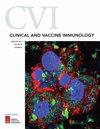Superior Protection from Live-Attenuated Vaccines Directed against Johne's Disease
Q2 Biochemistry, Genetics and Molecular Biology
引用次数: 23
Abstract
ABSTRACT Mycobacterium avium subsp. paratuberculosis (M. paratuberculosis) is the etiological agent of Johne's disease in ruminants. Johne's disease is an important enteric infection causing large economic losses associated with infected herds. In an attempt to fight this infection, we created two novel live-attenuated vaccine candidates with mutations in sigH and lipN (pgsH and pgsN, respectively). Earlier reports in mice suggested these vaccines are promising candidates to fight Johne's disease in ruminants. In this study, we tested the performances of the two constructs as vaccine candidates using the goat model of Johne's disease. Both vaccines appeared to provide significant immunity to goats against challenge from wild-type M. paratuberculosis. The pgsH and pgsN constructs showed a significant reduction in histopathological lesions and tissue colonization compared to nonvaccinated goats and those vaccinated with an inactivated vaccine. Unlike the inactivated vaccine, the pgsN construct was able to eliminate fecal shedding from challenged animals, a feature that is highly desirable to control Johne's disease in infected herds. Furthermore, strong initial cell-mediated immune responses were elicited in goats vaccinated with pgsN that were not demonstrated in other vaccine groups. Overall, the results indicate the potential use of live-attenuated vaccines to control intracellular pathogens, including M. paratuberculosis, and warrant further testing in cattle, the main target for Johne's disease control programs.约翰氏病减毒活疫苗的卓越保护
鸟分枝杆菌亚种;副结核是反刍动物约翰氏病的病原。约翰氏病是一种重要的肠道感染,对受感染的畜群造成巨大的经济损失。为了对抗这种感染,我们创造了两种具有突变的叹息和lipN的新型减毒活疫苗候选物(分别为pgsH和pgsN)。早期在老鼠身上的报道表明,这些疫苗很有希望用于对抗反刍动物的约翰氏病。在本研究中,我们使用山羊约翰氏病模型测试了这两种结构作为候选疫苗的性能。这两种疫苗似乎对山羊对野生型副结核分枝杆菌的攻击具有显著的免疫力。与未接种疫苗的山羊和接种灭活疫苗的山羊相比,pgsH和pgsN结构的山羊的组织病理学病变和组织定植显著减少。与灭活疫苗不同,pgsN结构能够消除受感染动物的粪便脱落,这是在受感染畜群中控制约翰氏病的一个非常理想的特征。此外,在接种了pgsN疫苗的山羊中引发了强烈的初始细胞介导的免疫反应,这在其他疫苗组中没有表现出来。总的来说,结果表明减毒活疫苗有可能用于控制细胞内病原体,包括副结核分枝杆菌,并且值得在牛身上进行进一步的测试,牛是约翰氏病控制计划的主要目标。
本文章由计算机程序翻译,如有差异,请以英文原文为准。
求助全文
约1分钟内获得全文
求助全文
来源期刊

Clinical and Vaccine Immunology
医学-传染病学
CiteScore
2.88
自引率
0.00%
发文量
0
审稿时长
1.5 months
期刊介绍:
Cessation. First launched as Clinical and Diagnostic Laboratory Immunology (CDLI) in 1994, CVI published articles that enhanced the understanding of the immune response in health and disease and after vaccination by showcasing discoveries in clinical, laboratory, and vaccine immunology. CVI was committed to advancing all aspects of vaccine research and immunization, including discovery of new vaccine antigens and vaccine design, development and evaluation of vaccines in animal models and in humans, characterization of immune responses and mechanisms of vaccine action, controlled challenge studies to assess vaccine efficacy, study of vaccine vectors, adjuvants, and immunomodulators, immune correlates of protection, and clinical trials.
 求助内容:
求助内容: 应助结果提醒方式:
应助结果提醒方式:


